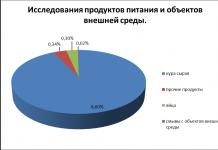Carbohydrates are a key ingredient in most foods and the main source of energy for humans. Depending on the number of structural units, carbohydrates are divided into simple and complex. Simple ("fast") carbohydrates are easily absorbed by the body and quickly raise blood sugar levels (that is, they are high), which can lead to a deterioration in metabolism and weight gain.
Complex carbohydrates (starch, fiber) are composed of many linked saccharides, including tens to hundreds of structural elements. Foods with these carbohydrates are considered healthier because, as they are digested, they release their energy to the body gradually, thus providing a stable and long-term feeling of fullness from food.
Most weight loss diets are based on the elimination of carbohydrates from the diet (or their limitation). At the same time, the most popular and effective diet for fast weight loss is one that involves a complete rejection of fast carbohydrates and the use of only a small amount of food with complex carbohydrates.
What foods contain carbohydrates?
Carbohydrates are found in almost all food products - however, with the exception of animal products (primarily different types meat and fish). Moreover, in natural herbal products food contains predominantly slow carbohydrates, while products with are most often manufactured industrially (from white sugar to baked goods).
| Food product name | Total carbohydrate content per 100 g | Sugar in the composition,% of all carbohydrates |
| Sugar | 100 g | 100% |
| Honey | 100 g | 100% |
| Rice (before cooking) | 80-85 g | <1% |
| Pasta (before cooking) | 70-80 g | 1-2% |
| Buckwheat and other cereals | 65-70g | 0% |
| Bread | 45-55 g | 10% |
| Sweet pastries | 40-50 g | 20% |
| Ice cream | 20-25 g | 90% |
| Fruit juice | 10-15 g | 100% |
| Cola and other sodas | 10 g | 100% |
The benefits of carbohydrates for the body
Let us recall that nutrients necessary for human life are divided into macronutrients (water, carbohydrates, fats, proteins) and micronutrients (vitamins, minerals, antioxidants). Each of the nutrients is unique and is used in a specific way in the metabolism. In this case, carbohydrates play a major role, being a key source of energy for living organisms.
Carbohydrates are needed both by the human brain (glucose is its key fuel) and by its muscles (carbohydrates are stored in them in the form of glycogen) and other organs. The body's need for various foods with carbohydrates is about 250-500 g per day, depending on the person's weight and the level of his daily physical activity.
However, the human body can exist practically without carbohydrates - in this case, it is rebuilt to use fat reserves and ketone bodies. Another effective diet without carbohydrates is built on this principle.
Carbohydrates: Simple and Complex

Once in the stomach, foods with fast carbohydrates of a high glycemic index (for example, table sugar, various sweets or even white rice) are transformed into blood sugar within a few minutes. Since high sugar levels are dangerous for the brain and various internal organs, the body tries to neutralize this increase as quickly as possible.
Unfortunately, the easiest way to dispose of excess fast carbs is to convert their calories into fat stores. At the same time, sharp fluctuations in blood sugar lead to hunger and a characteristic desire to again eat sweets. A vicious circle arises - a person gets fat from such products, but cannot refuse sweets. However, losing weight always starts with.
Fast Carbs: Food List
- sugar (including honey, sodas such as cola, and fruit juices)
- jams, preserves, marmalade and other sweets
- bread and all kinds of white flour pastries
- most sweet fruits
- White rice
What are complex carbohydrates?

Complex carbohydrates are primarily starch (the main carbohydrate in plants), glycogen (the main source of muscle energy) and food. Starch is essentially a collection of simple carbohydrate molecules tightly bound together. The body needs both time and energy to break down foods with complex carbohydrates. This is why complex carbohydrates are called "slow" and are healthier.
The main function of complex carbohydrates is both to support digestion processes (for example, fiber is responsible for the normal movement of digested food through the esophagus), and to store energy for physical activity. In addition, eating fiber and other complex carbohydrates normalizes blood glucose levels, which is especially important when dieting with diabetes mellitus.
Complex Carbohydrates: Food List
- various whole grains
- durum wheat pasta
- green vegetables
- Brown rice
- beans and other legumes
Glycemic index of food
As FitSeven mentioned above, the simpler the composition of a particular carbohydrate and the fewer saccharides it contains in its formula, the faster it is digested and released into the bloodstream, increasing sugar levels. Complex vegetable carbohydrates (a mixture of starch and fiber), made up of hundreds of linked building blocks, are absorbed much more slowly.
Recall that the rate of assimilation of a product with carbohydrates is directly related to its glycemic index (GI). Carbohydrates with a low glycemic index (for example, other grains) are absorbed slowly, causing a gradual increase in blood sugar, while carbohydrates with a high GI (table sugar, white flour) give their energy to the body as quickly as possible.
Healthy and unhealthy carbohydrates
The most beneficial for health (and for the figure) are complex carbohydrates of vegetables and other plants that have undergone moderate heat treatment. Then there are various grains (from wheat to corn), whole grains and fruits, which contain a lot of dietary fiber and have an average glycemic index.
Separately, we note that grains completely peeled from the shell (for example, white rice, white flour and various products from them) are neutral for the body, their excessive consumption can still lead to weight gain. Remember that most simple carbohydrate foods (including fruit juices) should be kept as limited as possible in a healthy diet.
Norms of carbohydrates for mass gain

The opinion that foods with carbohydrates are fattening and should be limited as much as possible in the daily diet is based on a misunderstanding of the glycemic index of simple and complex carbohydrates. In fact, carbohydrates should make up the bulk of the diet of a healthy person - they should account for 50 to 80% of the total calories (250-400 g per day).
Rates of carbohydrates for weight loss
There are many diets that promise rapid weight loss after removing carbohydrates from the diet - for example, or. While these diets may be effective for weight loss in the short term, they are ultimately considered not very healthy (with the exception of a gluten-free diet).
It must always be remembered that a complete rejection of food containing carbohydrates will deprive the body of most vitamins and minerals, which can lead to both an exacerbation of chronic diseases and the development of new ones. In fact, weight loss on protein diets is impossible without dire health consequences (3) - especially when it comes to weight loss of 10 kg or more.
***
Carbohydrates are the main source of energy for human life. All kinds of foods are a food source of carbohydrates. At the same time, it is necessary to separate the negative effects on health and weight gain from the excessive consumption of carbohydrate foods with a high GI and the benefits of complex plant carbohydrates and fiber.
Sources of data:
- Glucose: Energy Sources,
- Diet Percentages: Part 2, Lyle McDonald,
- Low Carb Diet: Health Risks,
Everyone now knows about the dangers of excessive sugar consumption, there is no debate about this - overweight, increased blood sugar levels and the risk of diabetes, increased blood pressure, etc.
But still we have to meet a lot of discussions that not all carbohydrates are harmful and in small quantities, some types will not do anything bad.
Let's consider a simple question - what does the use of carbohydrates lead to in principle?
1. Increased appetite.
Anyone who has tried any of the options for low-carbohydrate diets notes the fact that without carbohydrates, you almost don't feel like eating. Hunger comes gradually and takes a very long time to gain full strength. But as soon as you eat something sweet, a brutal appetite immediately awakens. Those. Eating even small amounts of carbohydrates greatly complicates the control of eating behavior.
2. Excess weight.
All carbohydrates, as we have discussed many times, first replenish glycogen stores and then are stored as fat. The body spends its reserves in the reverse order, at first it spends glycogen, and only then proceeds to the breakdown of fat.
Therefore, excess weight is so easy to gain and so difficult to go away. Where is the line for weight gain? Each organism has its own limit of carbohydrate consumption. On average, this is about 40 to 150 grams of carbohydrates per day. It is recommended to adhere to the limit of 20 grams in order to ensure that all glycogen stores are burned and not to allow it to accumulate (and, as a consequence,
3. Destruction of the body through glycation of proteins.
The glucose molecule is chemically very active; it easily reacts with various proteins, creating strong protein-carbohydrate complexes. Protein fibers become inflexible and deformed. Vessels and glycogen are damaged. hemoglobin worsens oxygen tolerance and becomes a risk factor for the development of diabetes mellitus, coronary heart disease, stroke and Alzheimer's disease.
Glycated proteins of the plasma membranes of the blood vessels of the kidneys interfere with the ability of the kidneys to remove urea, and of the blood vessels of the retina - vision; glycation of crystallins in the lens is the cause of cataracts.
In addition, with a constant excess of glucose and intracellular "shortage" of insulin, the proportion of insulin-independent glucose breakdown increases, as a result of which sorbitol alcohol is formed, an osmotically active substance that causes swelling of the walls of blood vessels.
All taken together disrupts the transport of oxygen and nutrients to the cells of all organs and tissues. With glycation, the production of free radicals increases tens of times, which leads to accelerated aging of cells.
4. Chronic inflammation.
Glycated proteins damage the walls of blood vessels over time, which leads to the development of chronic inflammation and further destruction of the body.
Each of these problems individually can be solved in different ways, but the reason is based on only one - exceeding the permissible level of carbohydrates. And removing all foods with their high content from the diet can be the basis for solving all these problems and rid ourselves of a lot of difficulties in the future.
A carbohydrate diet for weight loss is based on a sharp restriction or complete exclusion of simple carbohydrates from the diet and an increase in foods and meals from them with a high content of complex carbohydrates with a reduced rate of fat intake. This dietary program, which seems to many a paradox, is based on the acceleration of processes, which is due to the relatively rapid absorption of carbohydrates in the body.
The importance of carbohydrates in human nutrition is extremely high. First of all, it is the main source of utilized energy, which ensures vital activity. The energy function is performed mainly by glucose, fructose, glycogen, sucrose and starch. An important role is also played by "indigestible" carbohydrates (hemicellulose, cellulose, pectin), which stimulate the motor function of the gastrointestinal tract, adsorb toxic compounds, and create conditions for the normal functioning of the natural intestinal microflora.
Carbohydrates are represented by a large class of compounds and include both simple - monosaccharides , and complex - polysaccharides ... The effect of different types of carbohydrates on metabolism varies significantly.
Simple (quickly absorbed) carbohydrates - in the body are broken down into monosugar (glucose and fructose), which are quickly absorbed, and with an excess of their intake into the body and the absence of an immediate need for them, a complex mechanism of their transformation into subcutaneous and intra-abdominal fat is triggered. This type of carbohydrate quickly raises blood sugar levels, leading to feelings of fullness that pass away just as quickly. These include honey, sugar, confectionery, sweet fruits. Such sources of carbohydrates in the diet should be limited.
Complex (slowly absorbed) carbohydrates - starch, pectin, glycogen, inulin, fiber. The structure of the molecule is complex and includes dozens monosaccharides ... The process of their splitting occurs in the small intestine rather slowly (duration is 2-5 more), and the process of their absorption is slowed down by fiber. They slowly raise blood sugar levels and the body is evenly energized. It is these carbohydrates in food that should be the main source of energy and make up 95% of the daily value. These include various foods containing a lot of fiber, pectin, starch (cereals and cereals made from them, white rice, whole grain bread, bananas, pineapple, grapes, dried fruits, and others).
The pace of modern life, in which, unfortunately, there is not enough time either for proper rest or rational nutrition, makes itself felt by the malfunctioning of the body.
But there comes a time when in the "arms race" we still pay attention to constant fatigue, apathy, and a bad mood. And this is just the tip of the iceberg.
A little more time passes and we begin to be bothered by unpleasant sensations in the intestines and stomach. But that's not all: in the mirror, instead of a fit and slender beauty, we see a tired woman who slowly but surely begins to gain excess weight.
And the reason for such "amazing transformations" often lies in the wrong diet, namely in the lack of carbohydrates. How to fill this deficit, and what kind of carbohydrates, and we'll talk further.
Carbohydrates
Carbohydrates are the main suppliers of energy to the body: they provide the body with 50-60 percent of energy. Our brain especially needs carbohydrates.
It is also important that carbohydrates are an integral part of the molecules of some amino acids involved in the formation of enzymes and nucleic acids.
Carbohydrates are divided into two groups:
- complex (or complex) - polysaccharides contained in natural products;
- simple (they are also called easily digestible) - monosaccharides and disaccharides, as well as isolated carbohydrates present in milk, some fruits and products that have undergone chemical processing (in addition, carbohydrates of this group are found in refined sugar, as well as sweets).
It must be said that the human body in general and the brain in particular is mostly useful for complex carbohydrates that come with protein foods. Such carbohydrates have long molecular chains, so they take a long time to be absorbed. As a result, carbohydrates do not enter the bloodstream in large quantities, thereby excluding the strong release of insulin, which leads to a decrease in the concentration of sugar in the blood.
There are three types of carbohydrates:
- monosaccharides;
- disaccharides;
- polysaccharides.
Monosaccharides
The main monosaccharides are glucose and fructose, which consist of one molecule, due to which these carbohydrates are quickly broken down, instantly entering the bloodstream.
The cells of the brain are "fed" with energy thanks to glucose: for example, the daily rate of glucose required for the brain is 150 g, which is one fourth of the total volume of this carbohydrate received per day from food.
The peculiarity of simple carbohydrates is that they, being quickly processed, are not transformed into fats, while complex carbohydrates (if consumed excessively) can be deposited in the body as fat.
Monosaccharides are abundant in many fruits and vegetables, as well as honey.
Disaccharides
These carbohydrates, which include sucrose, lactose and maltose, cannot be called complex, since they contain the remains of two monosaccharides. Disaccharides take longer to digest than monosaccharides.
Interesting fact! It has been shown that children and adolescents respond to increased intake of carbohydrates from refined (or refined) foods, the so-called overactive (or hyperactive) behavior. By consistently eliminating foods such as sugar, white flour, pasta, and white rice from the diet, behavioral disorders will be significantly reduced. At the same time, it is important to increase the consumption of fresh vegetables and fruits, legumes, nuts, and cheese.
Disaccharides are found in dairy products, pasta and products containing refined sugar.
Polysaccharides
Polysaccharide molecules include tens, hundreds, and sometimes thousands of monosaccharides.
Polysaccharides (namely starch, fiber, cellulose, pectin, inulin, chitin and glycogen) are most important for the human body for two reasons:
- they take a long time to digest and absorb (in contrast to simple carbohydrates);
- contain many useful substances, including vitamins, minerals and proteins.
Many polysaccharides are present in plant fibers, as a result of which one meal, which is based on raw or boiled vegetables, can almost completely satisfy the body's daily requirement in substances that are sources of energy. Thanks to polysaccharides, firstly, the required level of sugar is maintained, and secondly, the brain is provided with the nutrition it needs, which is manifested by increased concentration, improved memory and increased mental activity.
Polysaccharides are found in vegetables, fruits, grains, meat, and animal liver.
The benefits of carbohydrates

- Stimulating the peristalsis of the gastrointestinal tract.
- Absorption and elimination of toxic substances and cholesterol.
- Providing optimal conditions for the functioning of normal intestinal microflora.
- Strengthening the immune system.
- Normalization of metabolism.
- Ensuring the proper functioning of the liver.
- Ensuring a constant flow of sugar into the blood.
- Prevention of the development of tumors in the stomach and intestines.
- Replenishment of vitamins and minerals.
- Providing energy to the brain, as well as the central nervous system.
- Promote the production of endorphins, which are called "hormones of joy".
- Easing the manifestation of premenstrual syndrome.
Daily carbohydrate requirement
The need for carbohydrates directly depends on the intensity of mental and physical activity, averaging 300 - 500 g per day, of which at least 20 percent should be easily digestible carbohydrates.
Elderly people should include in their daily diet no more than 300 g of carbohydrates, while the amount of easily digestible carbohydrates should vary between 15 and 20 percent.
With obesity and other diseases, it is necessary to limit the amount of carbohydrates, and this should be done gradually, which will allow the body to adapt to the altered metabolism without any problems. It is recommended to start the restriction with 200 - 250 g per day for a week, after which the amount of carbohydrates supplied with food is brought to 100 g per day.
Important! A sharp decrease in the consumption of carbohydrates for a long time (as well as their lack in nutrition) leads to the development of the following disorders:
- lowering blood sugar;
- a significant decrease in mental and physical activity;
- weakness;
- weight loss;
- violation of metabolic processes;
- constant sleepiness;
- dizziness;
- headaches;
- constipation;
- the development of colon cancer;
- hand tremors;
- feeling hungry.
The listed phenomena disappear after consuming sugar or other sweet foods, but the intake of such foods should be dosed, which will protect the body from gaining extra pounds.
Important! An excess of carbohydrates (especially easily digestible ones) in the diet, which contributes to an increase in sugar, is harmful to the body, as a result of which part of the carbohydrates is not used, going to the formation of fat, which provokes the development of atherosclerosis, cardiovascular diseases, flatulence, diabetes mellitus, obesity, and caries.
What foods contain carbohydrates?
From the list of carbohydrates below, everyone can make up a completely varied diet (considering that this is not a complete list of foods that contain carbohydrates).

Carbohydrates are found in the following foods:
- cereals;
- apples;
- legumes;
- bananas;
- cabbage of different varieties;
- whole grain cereals;
- zucchini;
- carrots;
- celery;
- corn;
- cucumbers;
- dried fruits;
- eggplant;
- wholemeal bread;
- lettuce leaves;
- low fat yogurt;
- corn;
- durum wheat pasta;
- onions;
- oranges;
- potatoes;
- plum;
- spinach;
- strawberries;
- tomatoes.
Only a balanced diet will provide the body with energy and health. But for this you need to properly organize your diet. And the first step to a healthy diet is a complex carbohydrate breakfast. So, a portion of whole grain porridge (without dressings, meat and fish) will provide the body with energy for at least three hours.
In turn, when eating simple carbohydrates (we are talking about sweet pastries, various refined products, sweet coffee and tea), we experience an instant feeling of fullness, but at the same time, a sharp rise in blood sugar occurs in the body, followed by a rapid decline, followed by hunger. Why is this happening? The fact is that the pancreas is very overloaded, since it has to excrete large amounts of insulin in order to process refined sugars. The result of this overload is a drop in sugar levels (sometimes below normal) and the appearance of a feeling of hunger.
In order to avoid the listed violations, we will consider each carbohydrate separately, determining its benefits and role in providing the body with energy.
Glucose
Glucose is rightfully considered the most important simple carbohydrate, which is the "building block" that is involved in the construction of most dietary disaccharides and polysaccharides. This carbohydrate contributes to the fact that fats in the body "burn" in full.

Important! For glucose to enter the cells, insulin is needed, in the absence of which, firstly, the blood sugar level rises, and secondly, the cells begin to experience a severe energy deficit.
Glucose is the fuel that supports all processes in the body without exception. Thanks to this carbohydrate, the body's full functioning is ensured with strong physical, emotional, and mental stress. Therefore, it is extremely important to maintain its constant level in the norm.
The blood glucose rate varies between 3.3 - 5.5 mmol / l (depending on age).
Benefits of glucose:
- neutralization of toxic substances;
- elimination of symptoms of intoxication;
- contributing to the healing of diseases of the liver, gastrointestinal tract, cardiovascular and nervous systems.
Lack or excess of glucose can lead to the development of such disorders and diseases:
- changes in acid-base balance;
- violation of carbohydrate-fat and protein metabolism;
- decrease or increase in blood pressure;
- diabetes mellitus;
- weakness;
- deterioration of mood.
What foods contain glucose?
Of all the variety of carbohydrate-containing foods, the highest amount of glucose is found in grapes (for this reason, glucose is often called "grape sugar").

In addition, glucose is found in foods such as:
- Cherry;
- watermelon;
- cherries;
- melon;
- raspberries;
- strawberries;
- plum;
- carrot;
- banana;
- pumpkin;
- figs;
- White cabbage;
- potato;
- dried apricots;
- cereals and cereals;
- raisin;
- pears;
- apples.
Also, glucose is found in honey, but only together with fructose.
Fructose
Fructose is not only the most abundant but also the tastiest carbohydrate found in all sugary fruits and vegetables, as well as honey.

The main advantage of fructose, which has a caloric content of 400 kcal per 100 g, is that this carbohydrate is almost twice as sweet as sugar.
Important! Unlike glucose, fructose does not need insulin to enter the bloodstream and then into the tissue cells: for example, fructose is removed from the blood in a fairly short period of time, so sugar rises much less than after consuming glucose. Thus, fructose can be consumed without harm to health by diabetics as a source of carbohydrates.
Benefits of fructose:
- normalization of blood sugar levels;
- strengthening the immune system;
- reducing the risk of caries, as well as diathesis;
- preventing the accumulation of carbohydrates;
- dulling the feeling of hunger;
- acceleration of recovery after intense physical and mental stress;
- reducing the calorie content of food.
Harm to fructose
Excessive consumption of fructose can trigger the development of diabetes, obesity and fatty liver. Why? This simple carbohydrate is the least (in comparison with other carbohydrates) stimulates the production of insulin, which over time can provoke an immunity to this hormone, which is a kind of indicator that signals satiety. In the event that insulin is not released, the body will not be able to assess the sufficient amount of energy, and, therefore, will continue to gain it, but already in the form of fatty deposits.
What foods contain fructose?
It is important to adhere to the average daily intake of fructose, which for an adult is no more than 50 g.

Fructose is found in the following foods:
- corn syrup and its offal;
- apples;
- grapes;
- dates;
- watermelon;
- pears;
- raisins;
- dried figs;
- blueberries;
- melon;
- persimmon;
- tomatoes;
- sweet red pepper;
- sweet onions;
- cucumbers;
- zucchini;
- white cabbage;
- honey;
- juices.
Sucrose (sugar)
Sucrose is a well-known white sugar called "empty carbohydrate" because it does not contain nutrients such as vitamins and minerals.

Discussions about the benefits and harms of this disaccharide do not subside today. Let's try to understand this issue.
The benefits of sugar
- Ensuring normal brain function.
- Increased efficiency.
- Lifting your mood, which is important in a modern life full of stress.
- Providing the body with energy (sugar is quickly broken down in the digestive tract into glucose and fructose, which are absorbed into the bloodstream).
In turn, a lack of sugar in the body can cause irritation, dizziness and severe headaches.
Sugar harm
- Metabolic disorders, which leads to the development of obesity and diabetes.
- Destruction of tooth enamel.
- Displacement of B vitamins from the blood, which can provoke sclerosis, heart attack and vascular diseases.
- Violation of the musculoskeletal system.
- Brittle hair and nails.
- The appearance of acne and allergic rashes.
In addition, an excessive love of sweets in children often develops into neuroses and becomes the cause of hyperactivity.
What to do? Give up sugar completely? But the benefits of this carbohydrate are undeniable. There is a way out - and this is moderation in the use of this product.
During the research, the optimal daily sugar intake was determined, which for an adult was 50-60 g, which corresponds to 10 teaspoons.
BUT! The "norm" refers to both sugar in its pure form and sugar contained in vegetables, fruits, juices, confectionery and other products that contain this carbohydrate. Thus, sugar consumption should be approached responsibly and carefully.
Important! There is an alternative to white sugar - and this is brown sugar that does not pass any additional purification after separation from the raw material (such sugar is also called unrefined). The calorie content of brown sugar is lower, while the biological value is higher. However, do not forget that the difference between refined and unrefined sugar is not very large, so the use of both types should be moderate.
What foods contain sucrose?
Natural sources of pure sucrose are sugar beets and sugar cane.

In addition, sucrose is present in sweet fruits, fruits, as well as berries and vegetables.
Lactose
Lactose, called "milk sugar", is a disaccharide that is broken down by the enzyme lactase in the intestine to glucose, as well as galactose, which are absorbed by the body. This carbohydrate is found in milk and dairy products.

The benefits of lactose:
- providing the body with energy;
- facilitating the absorption of calcium;
- normalization of intestinal microflora due to the development of beneficial lactobacilli;
- stimulation of the processes of nervous regulation;
- prevention of the development of cardiovascular diseases.
The harm of lactose
This carbohydrate can cause harm when the human body lacks (or is present in insufficient quantities) the lactase enzyme, which promotes the absorption of lactose. Lactase deficiency provokes milk intolerance and contributes to intestinal disorders.
Important! With lactose intolerance, it is recommended to use fermented milk products, in which most of this carbohydrate is fermented to lactic acid, which is well absorbed by the body.
Interesting fact! Pure lactose is used in the production of various food products, dietary supplements and medicines aimed at preventing and treating dysbiosis.
What foods contain lactose?
As mentioned above, milk and dairy products are the most fortified with lactose, which contain up to 8 percent of this carbohydrate per 100 ml of product.

In addition, lactose is present in such beloved foods:
- bread;
- products for diabetics;
- confectionery;
- powdered milk;
- whey and related offal;
- condensed milk;
- margarine;
- ice cream;
- coffee cream (both dry and liquid);
- sauces and salad dressings (ketchup, mustard, mayonnaise);
- cocoa powder;
- flavor enhancers.
Lactose is not found in the following foods:
- coffee;
- a fish;
- soy and its by-products;
- fruit;
- vegetables;
- eggs;
- nuts;
- vegetable oils;
- legumes and cereals;
- meat.
Maltose
"Malt sugar" - this is what is often called the natural disaccharide maltose.

Malt sugar is a product of the natural fermentation of malt found in sprouted, dried and milled cereals (we are talking about rye, rice, oats, wheat and maize).
Such sugar has a less sugary and sweet taste (as opposed to cane and beet sugar), due to which it is used in the food industry in the manufacture of:
- baby food;
- muesli;
- beer;
- confectionery;
- dietary products (such as biscuits and breads);
- ice cream.
In addition, it is maltose that is used in the production of molasses, which is an integral part of beer.
Maltose is not only an excellent source of energy, but also a substance that helps the body to obtain B vitamins, fiber, amino acids, macro- and microelements.
This disaccharide can be harmful if consumed excessively.
What foods contain maltose?
Maltose is present in large quantities in sprouted grains.

In addition, small amounts of this carbohydrate are found in tomatoes, oranges, yeast, honey, molds, as well as in pollen, seeds and nectar of some plants.
Starch
Starch belongs to the class of complex carbohydrates with high energy value and easy digestibility. This polysaccharide, passing through the gastrointestinal tract, is transformed into glucose, which is absorbed in a maximum of 4 hours. It is the share of starch that accounts for about 80 percent of carbohydrates consumed with food.

But! For maximum assimilation of this carbohydrate, it is not recommended to consume it simultaneously with protein products, for the digestion of which alkaline acid is required (it is also necessary for the assimilation of starch, which provokes the deposition of fat in the cells). In order for the assimilation of starchy vegetables to take place in an optimal mode, and the body receives the required amount of vitamins and microelements, the consumption of starch should be combined with the intake of fats contained in vegetable oil, cream and sour cream.
Benefits of starch:
- lowering the content of cholesterol in the blood serum, as well as in the liver, which prevents the development of sclerosis;
- removing excess water from the body;
- removal of inflammatory processes, which is especially important for people with ulcers;
- normalization of digestion;
- normalization of metabolism;
- slowing down the absorption of sugar, which helps to reduce its level after eating;
- reduction of skin irritation.
Starch harm
Starches are natural (found in natural products) and refined (obtained under industrial conditions). It is precisely refined starch that is harmful, increasing inulin in the process of digestion and contributing to the development of atherosclerosis, pathology of the eyeball, metabolic disorders and hormonal balance.
Therefore, if possible, products containing powdered starch should be excluded from the diet (one of these products is premium flour bread).
Important! Consuming excessive amounts of natural starch can lead to flatulence, bloating, and stomach cramps.
What foods contain starch?
A large amount of starch is found in cereals and legumes, cereals, pasta, mango, bananas, root vegetables, and tubers.

Starch is also present in the following products:
- zucchini;
- carrots;
- rye, rice, corn and wheat flour;
- beets;
- potatoes;
- oat and corn flakes;
- soybeans and its by-products;
- bread;
- horseradish;
- ginger;
- garlic;
- pumpkin;
- artichokes;
- kohlrabi;
- chicory;
- mushrooms;
- sweet pepper;
- parsley and celery root;
- radish.
Important! To preserve the nutritional and beneficial properties of starch, it is recommended to steam starchy foods or consume them fresh.
Important! Thermally processed foods containing starch are harder to digest than raw foods.
Interesting fact! To check if a vegetable or fruit contains starch, you can do a simple test in which a drop of iodine is dripped onto the cut of the vegetable or fruit. If the drop turns blue after a few minutes, the product being tested contains starch.
Cellulose
Fiber, which belongs to the class of polysaccharides, is the fiber that forms the basis of plants (this includes fruits and vegetables, berries and roots).

Important! Fiber is practically not absorbed into the intestines, but at the same time it takes an active part in the normalization of the gastrointestinal tract.
The benefits of fiber:
- the formation of feces;
- improving the motor function of the intestines;
- prevention of constipation;
- promoting the elimination of cholesterol;
- improved bile secretion;
- dulling the feeling of hunger;
- absorption and removal of toxins and toxins;
- promoting the digestion of carbohydrates;
- prevention of cardiovascular diseases and colon cancer;
- preventing the formation of gallstones;
- maintaining normal intestinal microflora;
- contributing to the reduction of body fat.
Important! Fiber interferes with the rapid absorption of monosaccharide glucose in the small intestine, thereby protecting the body from a sharp drop in blood sugar.
What foods contain fiber?
The required daily intake of pure fiber (that is, excluding the mass of the product from which this carbohydrate is obtained) is at least 25 g.

High amounts of fiber are found in the outer covers of grains, seeds and beans, as well as in the skins of vegetables and fruits (especially citrus fruits).
In addition, the following foods contain this polysaccharide:
- bran;
- cereals;
- nuts;
- sunflower seeds;
- berries;
- bakery products made from wholemeal flour;
- dried fruits;
- greenery;
- carrots;
- cabbage of different varieties;
- green apples;
- potatoes;
- seaweed.
Important! Fats, sugars, dairy products, cheeses, meats and fish are fiber-free.
Cellulose
Cellulose is the main building material used in the plant kingdom: for example, the soft upper part of plants mainly contains cellulose, which includes such elements like carbon, oxygen, hydrogen.

Cellulose is a type of fiber.
Important! Cellulose is not digested by the human body, but it is extremely useful for him as a "roughage".
The benefits of cellulose
Cellulose perfectly absorbs water, thereby facilitating the work of the colon, which helps to effectively fight such disorders and diseases:
- constipation;
- diverticulosis (formation of saccular bowel wall protrusions);
- spasmodic colitis;
- haemorrhoids;
- colon cancer;
- phlebeurysm.
What foods contain cellulose?

The following foods are fortified with cellulose:
- apples;
- beet;
- brazil nuts;
- cabbage;
- carrot;
- celery;
- green beans;
- pear;
- peas;
- non-crushed cereals;
- bran;
- pepper;
- lettuce leaves.
Pectin
From the Greek language, the name of this carbohydrate, which is one of the types of fiber, is translated as "curdled" or "frozen". Pectin is a purely vegetable based adhesive.

Entering the body, pectin performs a double function: firstly, it removes harmful cholesterol, toxins and carcinogens; secondly, it provides tissues with glucose, which reduces the risk of developing cardiovascular diseases, diabetes mellitus and cancer.
Benefits of pectin:
- stabilization of metabolism;
- improvement of peripheral circulation;
- normalization of intestinal motility;
- elimination of manifestations of chronic intoxication;
- enrichment of the body with organic acids, vitamins and minerals;
- slowing down the absorption of sugar after eating a meal, which is extremely beneficial for people with diabetes.
In addition, this carbohydrate has enveloping, astringent, anti-inflammatory and analgesic properties, which is why it is indicated for people with gastrointestinal disorders and peptic ulcer diseases.
The harm of pectin
With excessive use of pectin, the following reactions may occur:
- decreased absorption of useful minerals such as iron, calcium, magnesium and zinc;
- fermentation in the colon, accompanied by flatulence and a decrease in the digestibility of proteins and fats.
Important! With natural products, pectin enters the body in small doses that cannot lead to an overdose, while this polysaccharide can be harmful to health with excessive consumption of dietary supplements.
What foods contain pectin?
The daily intake of pure pectin is about 20-30 g. If the diet is enriched with fruits, vegetables and herbs, then there is no need to get pectin from synthetic additives.

List of products containing pectin:
- apples;
- citrus;
- carrot;
- cauliflower and white cabbage;
- dried peas;
- green beans;
- potato;
- greenery;
- strawberries;
- Strawberry;
- roots.
Inulin
Inulin belongs to the class of natural polysaccharides. Its action is similar to that of a prebiotic, that is, a substance that, almost not being adsorbed in the intestine, activates metabolism and the growth of beneficial microflora.

Important! Insulin is 95 percent fructose, one of the functions of which is to bind glucose and remove it from the body, thereby lowering the concentration of sugar in the blood.
The benefits of inulin:
- elimination of toxins;
- normalization of the digestive tract;
- improving the absorption of both vitamins and minerals;
- strengthening the immune system;
- reducing the risk of developing cancer;
- elimination of constipation;
- improved absorption of insulin;
- preventing the formation of blood clots;
- normalization of blood pressure;
- promoting the excretion of bile.
Important! Inulin is easily absorbed by the human body, as a result of which it is used in diabetes mellitus in medicine as a substitute for starch and sugar.
What foods contain inulin?
Jerusalem artichoke is rightfully recognized as the leader in terms of inulin content, the edible tubers of which, in their taste, resemble the familiar taste of potatoes. So, the Jerusalem artichoke tuber contains about 15 - 20 percent inulin.

In addition, inulin is found in foods such as:
- garlic;
- chicory;
- banana;
- dandelion;
- echinacea;
- barley;
- rye;
- burdock;
- elecampane;
- agave.
Interesting fact! Today, inulin is actively used in the production of many food products, as well as beverages: ice cream, cheeses, meat products, muesli, sauces, juices, baby food, bakery, pasta and confectionery products.
Chitin
Chitin (translated from Greek "chitin" means "clothing") is a substance that is part of the external skeleton of both arthropods and insects.

Interesting fact! Chitin is one of the most widespread polysaccharides in nature: for example, about 10 gigatons of this substance is formed and decomposed in living organisms on planet Earth every year.
Important! In all organisms that produce and use chitin, it is not present in its pure form, but only in combination with other polysaccharides.
The benefits of chitin:
- protection against radioactive radiation;
- suppression of the growth of cancer cells by neutralizing the action of carcinogens and radionuclides;
- prevention of heart attacks and strokes by enhancing the effect of drugs that promote blood thinning;
- strengthening the immune system;
- lowering blood cholesterol levels, which prevents the development of atherosclerosis and obesity;
- improving digestion;
- stimulating the growth of beneficial bifidobacteria, which contributes to the normalization of the digestive tract;
- elimination of inflammatory processes;
- acceleration of tissue regeneration processes;
- lowering blood pressure;
- lowering blood sugar.
What foods contain chitin?
Chitin is found in its pure form in the outer skeleton of crabs, shrimps and lobsters.

In addition, this substance is present in certain types of algae, in mushrooms (honey agarics and oyster mushrooms are the most popular among our compatriots), and yeast. By the way, the wings of butterflies and ladybirds also contain chitin.
But that's not all: for example, in Asian countries, the lack of chitin is replenished by eating locusts, crickets, beetles and their larvae, worms, grasshoppers, caterpillars and cockroaches.
Glycogen
Glycogen (this carbohydrate is also called "animal starch") is the main form of glucose storage, and this kind of "conserved energy" in a short period of time can compensate for glucose deficiency.

What is it about? Carbohydrates that enter the body with food, during the passage of the digestive tract, are broken down to glucose and fructose, which provide the human systems and organs with energy. But some of these monosaccharides enter the liver, being deposited in it in the form of glycogen.
Important! It is glycogen, "conserved" in the liver, that plays an important role in maintaining the concentration of glucose in the blood at the same level.
Important! Glycogen, concentrated in the liver, is almost completely depleted after 10 - 17 hours after eating, while the content of muscle glycogen decreases significantly only after prolonged and intense physical exertion.
A decrease in glycogen concentration is indicated by the appearance of a feeling of fatigue. As a result, the body begins to receive energy from fat or from muscles, which is extremely undesirable for those who purposefully build muscle mass.
The consumed glycogen must be replenished within one to two hours, which will help to avoid an imbalance between fats, carbohydrates, proteins.
What foods contain glycogen?
Glycogen is absent in foods in its pure form, however, to replenish it, it is enough to eat carbohydrate-containing foods.
Carbohydrates - what do we know about them? Considering the increased interest of modern nutritionists in them, they are one of the most important macronutrients. And at the same time, the most dangerous - after all, it is the main source of energy or calories that turn into excess weight. However, not all saccharides bring harm, but only those that hide behind the prefix "mono". But first things first.
Many people have preferred sucrose and fructose - simple and refined carbohydrates - to starch, glycogen and fiber. Consequences - a wave of obesity among adults and children, diseases directly related to overweight - diabetes mellitus, hypertension.
How are slow macronutrients different from fast ones? Nutritionists around the world have studied their effects on human health and performance. And they discovered that even these two groups have their own varieties. We will talk about them, as well as about the products containing the most useful carbohydrates, in this article.
Simple and fast
In another way, they are called monosaccharides. Scientists have discovered more than two hundred macronutrients belonging to this class, but they are not known to everyone. Most often we hear about the following types:
- Glucose
Or dextrose. It is a pure sugar found in confectionery, soda, bars and other foods loved by both children and their parents. Is it worth it to get so carried away by something that causes an unbridled desire to eat or drink more? One glass of the sweet fizzy drink contains 5.25 teaspoons of sugar. It is hardly necessary to talk about how dangerous such a sugary energy supply is for our figure.
- Galactose

Monosaccharide found in animal products. Galactose is similar in composition to glucose. Most of all it is in lactose. The blood level of this carbohydrate in a healthy person should remain at around 5 mg / dL. Each of us gets our daily allowance by consuming dairy products. One of the known plant sources of a monosaccharide belonging to the class of hexoses is celery. It contains more of this important substance than root crops.
- Fructose

It is converted into glycogen in the liver. Therefore, it is used as one of the main ingredients in sports energy drinks. This type of simple carbohydrate is found in both natural and artificially produced foods. It can be found in sugar and corn syrup, ketchup, convenience foods, cakes, and other weight-promoting foods.
Why are simple and fast carbohydrates so dangerous for our figure?
They almost instantly enter the bloodstream and provoke an increase in glucose levels.
All we feel is energetic satiety, followed by fatigue and hunger.
Monosaccharides do not nourish, but only provoke us, whet our appetite. Hence the urge to grab a double portion of fries at fast food restaurants, to eat another candy, brownie, or a slice of cake.
By increasing portions and eating the wrong way, you not only gain excess weight, but also health problems. This is the harm of fast carbohydrates.
Learn more about our weight loss programs:
Products containing monosaccharides are not recommended for weight loss. They are also rejected by athletes who need to gain muscle mass. The reason is the same - these macronutrients instantly turn into fat, lower the level of insulin in the blood, you always want more and more of them. The result of excessive consumption of sweet and unhealthy foods is a vicious cycle of "eat-get-fat-eat again", leading to the development of obesity.
Can Fast Carbohydrates Be Good?
Athletes speak about the positive effect of monosaccharides, who note the effect of carbohydrates on the process of burning fat during intense strength loads. However, the rules of professional bodybuilding in the life of an ordinary person far from the gym do not work.
Simple carbohydrates are most dangerous for our figure in the afternoon. It is at this time that the body is especially actively converting them into fat.

Monosaccharides are found in:
- Sahara
- Sweets
- Preserves, jams and other home and store preparations
- Milk chocolate
- Soda, milkshakes
- Some fruits (grapes, bananas, etc.)
If you are watching your figure, it is in your best interest to reduce your intake of foods containing simple carbohydrates or eliminate some of them - for example, sugary confectionery, refined sugar (replacing it with stevia), milk chocolate (in exchange for bitter),
Why complex carbohydrates are good for the body
Now let's turn to polysaccharides - they are called so because they contain several chains of monosaccharide molecules.
- Starch

It is abundant in potatoes, baked goods, pasta, cereals and some legumes, as well as in rice. The beneficial properties of starch are to slow down the absorption of sugar and a prolonged feeling of fullness after eating, and to improve bowel function. However, you should not abuse this polysaccharide if you do not want to earn colic, flatulence and new kilograms.
- Cellulose

Coarse dietary fiber found in plant foods. Fruits and vegetables stored raw accumulate this important component, losing vitamins and minerals. During heat treatment, the beneficial substances of this polysaccharide come to naught - the effect of quenching is especially strong.
Accumulating in the body, fiber forms a "food lump" in it, which moves through the intestines without lingering in it. The most important function of dietary fiber is to maintain the normal functioning of the gastrointestinal tract. Their lack leads to constipation, irregular bowel movements, congestion in the pelvic region.
Fiber plays a huge role in the diet of those who are losing weight. Eating an apple containing this polysaccharide will leave you full for a long time. No wolfish appetite - no overeating and extra pounds. Dietary fiber also normalizes metabolism - the body begins to work like a clock. Reduces the risk of developing cardiovascular diseases, colon cancer, diabetes.
- Glycogen

It contains glucose molecules that are stored in reserve. How? After eating, it enters the bloodstream - sometimes in excess. It is this extra energy material that goes into storage in the form of glycogen. When blood sugar levels drop, a complex macronutrient is broken down. So our condition is normalized, and the body receives the necessary nutrition.
So, the question of which carbohydrates are the most useful can be answered with confidence - complex ones. It is they that allow us to stay in good shape for a long time, without feeling hungry, they do not allow insulin to rise in leaps and bounds - as is the case with monosaccharides.
Where to get energy fuel for the body
We have already told where to look for simple carbohydrates - they are found in abundance in those foods that children love so much - everything is sweet and harmful. Dangerous fat derivatives are found not only in confectionery, but also in products that we used to consider healthy - fruits, even cereals with sugar, presented by manufacturers as healthy food.
But depriving yourself of melons, bananas, grapes, carrots, honey, corn and other fruits, vegetables and favorite foods is not worth it - the body needs them as a source of essential vitamins and minerals. Count calories and eat sweet fruits and vegetables before 4:00 pm - after that time they are instantly transformed into fats, and we do not need this.
See the table for a list of weight loss foods that contain the right and healthy "slow" carbohydrates.

Do not forget: the higher the glycemic index, the worse for our figure. Don't skip foods that contain fiber. Coarse fiber is part of a complete diet, and monosaccharides are a blow to our figure and health. Eat right - that's enough to make your weight problems a thing of the past.
The benefits of some of the foods on the list that contain complex carbohydrates and are indispensable for losing weight must be said separately.
Oatmeal - our usual porridge - is a real storehouse of dietary fiber. Prepare it with pieces of fruit in milk or water - such a start to the day will provide a boost of vivacity and strength for several hours.

Seeds and nuts are sources of fiber, which saves us from hunger and makes the body work properly, acting like a stiff brush that sweeps out waste and toxins. Do not forget that almost all nuts are very high in calories - eat a little, but for the benefit of yourself.

Zucchini - contains not only the dietary fiber we need, but also vitamins B, A and C. Consuming this natural source of essential substances will help lower blood cholesterol levels and normalize metabolism. Zucchini can be added to salads and soups, baked - it all depends on your culinary imagination.

Celery - in addition to valuable fiber, contains proteins, vitamins, minerals and amino acids, helps to slow down the aging process and stimulates digestion by regulating the work of the gastrointestinal tract. It can be used to make not only a delicious salad, but also vegetarian cutlets, as well as a fragrant and delicate cream soup.

Beans - Complex carbohydrates found in legumes saturate for a long time. Another property of beans, appreciated by nutritionists, is that it interferes with the assimilation of starch that enters the body with other food. And it also allows you to show the culinary skill in all its glory - it can be stewed, baked, boiled, made a light soufflé or steam cutlets.

Apples - they have a lot of fiber, pectin, vitamins, trace elements and a minimum of calories. They not only improve metabolism and perfectly saturate, but also normalize the work of the heart and blood vessels. Apples can be boiled, baked, added to homemade baked goods - diversify your menu by inventing new healthy combinations.

How to cook foods with complex carbohydrates
There are several rules that will help you switch to a healthy diet and lose weight without denying yourself to culinary delights:
- Look for new flavors

Spice up your habitually sweet oatmeal by adding fancy spices.
- Remember to keep track of your calorie intake

To do this, keep a special diary and write down the calories of each dish in it. All results must be fair - otherwise, you will not wait for weight loss.
- Choose only useful combinations

For example, make a bright and delicious salad with spinach and beets, stew beef with carrots, serve fish with grilled vegetables, and season durum wheat pasta with a light sauce of lemon juice, olive oil and finely chopped garlic.
Our experts will help you figure out which carbohydrates are best left in your past life, and which ones to take with you to a new one - slim and happy. We will draw up an individual program, give advice on proper nutrition and tell you how to lose weight easily and simply without giving up your favorite dishes.



































